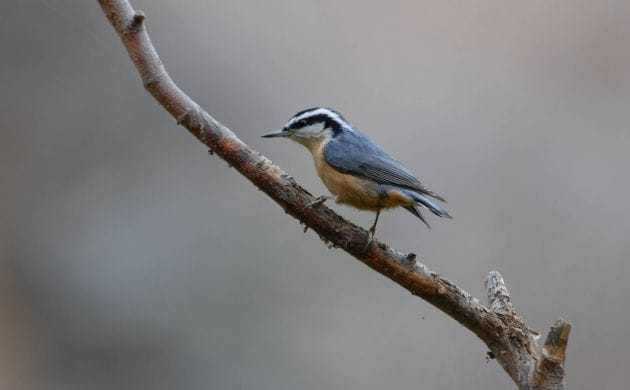
No time for preambles, philosophical diversions, or fancy-pants literary techniques today: I’m back in Montana and we have more big news from my bird feeder.
This week brought heavy snow to our valley, and so it seemed like it was time to get back down to the business of distributing seeds. Sure enough, the >Dark-eyed Juncos and Black-capped Chickadees who are my best customers showed up almost immediately (even before the squirrels.) Over the next few days the rest of the regulars trickled in — House Finches, a Red-Breasted Nuthatch, and a Northern Flicker who prefers to scope things out from a distance.
That alone made me happy (well, maybe not the squirrels). But on Wednesday, as I scanned the flocks, I noticed a bird that I didn’t recognize. It was bigger and paler than anything I was expecting. At first my brain went to Hoary Redpoll — there have been a few around Montana this season — but a few seconds with the binoculars told me I was looking at a sparrow, one that I couldn’t quite place. Besides the size and white, unstreaked belly, it had a very pink beak, buff cheeks, and a white throat marked with an uneven black near-bib, like a necklace with a heavy pendent.
Sibley helpfully told me that this was a juvenile Harris’s Sparrow. Which made me go a little nuts.
Harris’s Sparrow has a winter range that extends well into the prairies of eastern Montana, but these are the mountains. Here, the prince of the Zonotrichias falls into that vagrant category where no one is likely to doubt my record but I still feel that I have grounds to get excited — one individual shows up perhaps every third Christmas Bird Count. I snapped a bunch of pictures, all terrible but some at least sort of showing the field marks, and watched until it flew away.
Thursday it was back, as it seemingly travels with “my” pack of juncos. This makes sense, since they share feeding and habitat preferences. I haven’t seen it yet today, but I live in hope. If only my neighbors will keep their cats in.
Also Thursday, though, the regulars decided to remind me that they are equally as lovable as any rarity. Or maybe I just waited too long to top up the seed. Either way, when I went out with a handful of peanuts and sunflower hearts, a Red-breasted Nuthatch took a chance and landed on my fingers to get first pick of the meal. It was so light that except for the needling of its claws it almost wasn’t there. And then, satisfied with the peanut it selected, it wasn’t there at all. But still, will a Harris’s Sparrow do that?













Oh wow, the dream of my winter walks through Ann Arbor’s arboretum back in the winter of 2006/07. Amazing! Truth be told, a Harris’s Sparrow at a backyard feeder – well, anywhere, really – clearly beats a male Smew at a heated bird bath in a Missoula backyard. And nuthatches on your hand? Way crazy!!
Jochen: I wouldn’t say better. It’s just that with all the warm weather here, I think your Smew went astray. So much open water to choose from!
By the way, have you liked my recent focus on common, not-depressing birds?